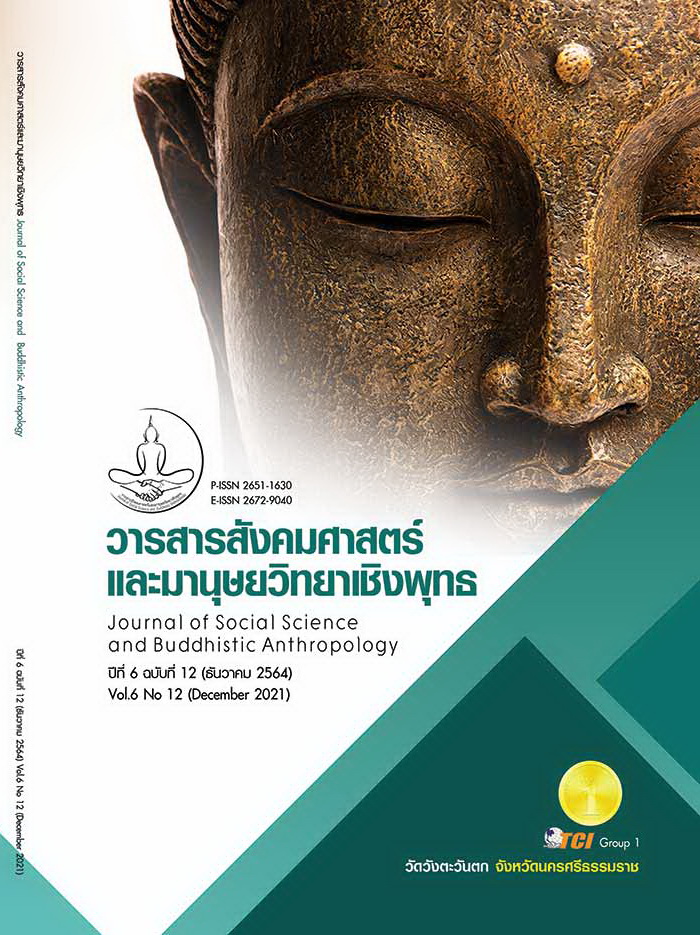The AESTHETIC OF URBAN LIVING SOCIETY UNDER THE SHADE OF BUDDHISM
Keywords:
Aesthetic, Urban living environment, Under the shade of BuddhismAbstract
This article aims to reflect the Thai way of living, traditional culture, and living environment of Thai people in the past, surrounded by natural picturesqueness, full of compassion, generosity, and kindness of people by harmonious sufficient lifestyle following the Buddhism principle guideline for living. Until Thailand has been moved into globalization, follow the footsteps of western civilization lifestyle it is becoming a part of Thai living. Looking back into the past before the big revolution of Thai society, Thailand is the country that connects to agriculture. We lived surrounded by nature, almost of local people is the farmer who lives so humbly. According to the big change that so impacts and affects the lives of Thai society, it started with changing the regime in 1932 B.C. and beginning with the National Economic and Social Development Plan in 1961 B.C. onwards. From the way, life and living in harmony with the nature of Thai people in simple and tranquility move forward to urban lifestyle such as flat and condominium surrounded with social problems, in the midst of chaos and pollution by lacking hygienic which caused the living environment in urban society. This research article aims to 1) decode the Buddhism principle 2) integrated into the living environment by encouraging the culture of living for Thai people back to simple, beauty, and humility both physically and mentally. This will lead to the aesthetic of living environment in the way of clean, bright, and peaceful by discovering the essence of living under Buddhism's shade, which blends into aesthetic balance for the living environment. This research is qualitative research with documentary study, site survey, and focus group. The research aims to provoke the understanding and enlightenment about simply living between Thai society and Buddhism to educate people. Furthermore, the research's goal is to spread Buddhism’s knowledge that be a part of Thai society for so long.
References
จี ศรีนิวาสัน. (2534). .สุนทรียศาสตร์ : ปัญหาและทฤษฎีเกี่ยวกับความงามและศิลปะ, แปลโดย สุเชาวน์ พลอยชุม, (กรุงเทพฯ: โครงการตำราภาควิชาปรัชญาและศาสนา คณะมนุษยศาสตร์ มหาวิทยาลัยเกษตรศาสตร์.
จักรสิน น้อยไร่ภูมิ. (2557) .เขียวขบถ หลากวิถีสถาปัตยกรรมสีเขียว, โรงพิมพ์ภาพพิมพ์, ตุลาคม
ติช นัท ฮันห์, (2530).ด้วยปัญญาและความรัก แนวปฏิบัติสำหรับชีวิตและสังคมใหม่, รสนา โตสิตระกูล แปล, บริษัทเคล็ดไทย จำกัด.
ผุสดี ทิพทัส. (2525). บ้านในกรุงเทพฯ: รูปแบบและการเปลี่ยนแปลงในรอบ 200 ปี (พ.ศ.2325-2525), กรุงเทพมหานคร
พุทธทาสภิกขุ. (2540). ชุมนุมปาฐกถา ชุด พุทธธรรม, กรุงเทพมหานคร : สำนักพิมพ์สุขภาพใจ.
พระไพศาล วิสาโล. (2550). เส้นโค้งแห่งความสุข1, เรียกใช้เมื่อ 19 มิถุนายน 2563 จาก http://www.visalo.org/book/senKoongHangKwamSuk.
พระพรหมคุณาภรณ์ (ป.อ.ปยุตฺโต). (2538), พจนานุกรมพุทธศาสตร์ ฉบับประมวลศัพท์, (กรุงเทพมหานคร : มหาวิทยาลัยมหาจุฬาลงกรณ์ราชวิทยาลัย, 344 หน้า.
สุวิญ รักสัตย์. (2556). ปลูกความงาม, คัมภีร์สุวิญญมาลา, (ห้างหุ้นส่วนจำกัด บางกอกบล๊อก, กันยายน
สุเชาวน์ พลอยชุม.(2545). สุนทรียศาสตร์ ปัญหาและทฤษฎีเกี่ยวกับความงามและศิลปะ, (กรุงเทพ : มหามกุฎราชวิทยาลัย.
เสริบศักดิ์ แสงสุข. (2557). การพัฒนาคุณภาพชีวิตตามแนวทางพระพุทธศาสนา, เรียกใช้เมื่อ 3 เมษายน 2563 จาก http://phd.mbu.ac.th/index.php/








